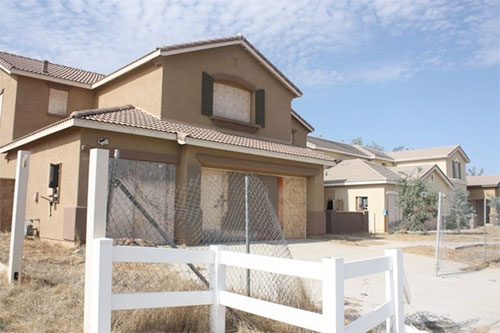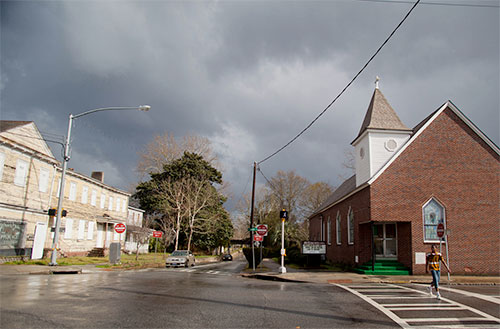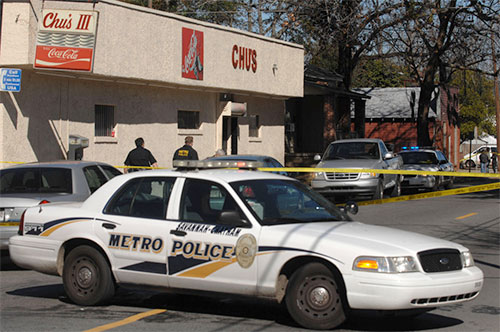Life & Island Times: American Borderlands
Editor’s Note: This is a very personal introspection from shipmate Marlow on his new ‘hood in South Carolina. Regardless of the specific GPS coordinates, we are truly in terra incognita now, aren’t we?
– Vic
Almost every day I travel here in Savannah through local borderlands. What I see and hear in these places reminds me of what I saw in similar locales and how they changed during my two wheeled travels in America’s new frontiers over the years since the late 90s.
This recent realization forced me to go back and look at my road trip journal notes. They were initially full of Americana things. In retrospect these earliest sightings and descriptions captured the vanishing externals of what became America’s new and vast impoverished borderlands.
These peripheries are everywhere – big and small cities, inner cities and suburbs, countrysides, mountains, flat lands, oceanside and the desert. They appear without warning. Most of us pass through without seeing them. We slip in and out of them almost unnoticed by those who remain and live there.
These edge places tell us a great deal about our hearts. We learn about our nation’s territory, prejudices, fears, and obsessions. Our virtues and loves also materialize as these places deal with what they want, lost, desire, fear, despise, and are ignorant of. The Great Recession was the final blow to many of them, irrevocably changing them including the residents’ and outsiders’ perception, meaning and extent of American borderlands.
These places were frontiers two centuries ago and became through hard word central pieces in what made America exceptional. Since the onset of globalism, the networked, just-in-time world economy and the Great Recession’s constant body blows, they have become hollow, drug infested, often disorderly and violent, and operate according to their own rules and conventions. They are distinct in many ways from the adjacent places they stand between. Some might unfairly label their inhabitants hillbillies, rednecks or worse.
When globalized trade trumped Made in the USA, the middle class economic well-being and social fabric of these places was threatened and then turned upside down.
The places I visited during those twenty years of motorcycle riding never served as way station shantytowns or downscale housing but had gone straight into a rapid decline. These abrupt changes were astounding. They included small and medium sized towns, suburbs and bankrupt farms with fallow fields. Once this had occurred, the resulting stark places had no appeal to passers through. It was if they had vanished to all but the careful observer who had seen and remembered them before the Great Change.
These new borderlands all possessed certain traits — broken down cars, trash and junk piles, deteriorating homes, duplexes, and business districts. One marker was not visible but its absence was telling. The human markers of these places financial hardship and social disintegration were nearly invisible, since it seemed that they were ashamed of what had befallen them and stayed out of sight.
It was spooky to see so many once vibrant places had gone and passed away.
These were places, so I thought back when I first noticed these changes, where the destitute inhabitants had no alternatives and might become angry some day, then later on distrustful and ultimately despairing. This potential one-dimensional no-hope outlook to my eyes hadn’t at that time displaced the dignity and compassion that many of those left behind felt for one another.
When I stayed at the inexpensive extended stay motels during my travels in these borderlands, I surmised there were many things that could have lead its long term residents to becoming homeless or near homeless. First for many of them, they were on the edge and hadn’t made a dime for a while since the factory or retail store where they worked closed and their unemployment had run out.
Logically the next thing they did was to hock their things. Then, they sold a little this at a yard sale or a little that on eBay to make a rent payment. Then, out of things to sell they were forced out of their houses and stayed with friends or family if they were lucky to have them close by in town. When those lifelines ran out, they were out of housing and on the street. If they were lucky, they had a car to stay in but that sooner or later was repossessed or sold to get something to eat or get high to numb the pain.
They were then faced with the task to get somewhere or do something just to get by the day. At this point, they no longer thought or spoke about the future, everything was about the growl in the stomach, chill on the neck, the pain in the body, heart, mind and soul.
Their American middle class life’s soft nuances had been replaced with hard indignity and sharp hunger that came with harrowing poverty. I couldn’t take photos of those I saw in this condition. It seemed to be an intrusion to ask them to pose in dignified despair. So I took pictures of these borderlands’ public places. Mostly they were of their streets, buildings, parks, churches, cemeteries, stores and factories that were long empty, abandoned or in decay. I have shared a few of these previously with you.

Suburban Georgia borderland
None of these new borderland poor were warned what was in store for them. The changes in their luck weren’t sudden enough to trigger external or internal alarm bells. The unpleasant news was never delivered but visited upon them slowly.
It took a fair amount of time for the newly poor to realize their true situation. Those in my acquaintance were high school or better educated from middle class families which probably caused them to delay seeing the reality – “We couldn’t possibly be ‘poor’ or need ‘assistance.’” But some told me, they found themselves choosing between rice, oatmeal, pasta or potatoes for every meal. Remembering that I had done so back in the early 70s, it finally occurred to me that being poor isn’t about how hard you work.
Many borderlanders finally applied for assistance and received a phone call months later notifying them that they were qualified for Medicaid and the Supplemental Nutritional Assistance Program, i.e., food stamps. By this time, there was no pretense about shame, these folks were excited to be able to eat more regularly. “We’ll have food,” they thought. “Good food! And medical care!”
Most can’t think, let alone talk, about food assistance and their first experience using it, without smiling. The memory of coming home and telling their kids “I have a surprise. I have bought a lot of food” is priceless. I know this, since I heard young Navy enlisted men’s wives say it when I was in the Navy back in the day.
I was poor for about five years during college through my first year in the US Navy. Married with one and then two girls, I didn’t know we were poor until years later. In late 1977, when I took young married junior enlisted sailors from my squadron down to the federal building to apply for food stamps, I found out that I had qualified for assistance for almost five of the previous eight years. Still the families would have much more food all month long, while we were on 7-8 month long deployments.
My personal family “poverty” wasn’t a life-crushing force for me, but I was always hungry, deferring my appetite to provide the girls with delicious, healthy food. Consequently, I worked pre-Navy two or three jobs, be they seasonal, full or part time or off-the-books side jobs as a day laborer to make ends meet.

East side Savannah borderland
It was exhausting, but my belief that hard work and effort mattered kept despair and desperation out of my mind. I was a full subscriber of the American idea that if someone just pulls himself up by the bootstraps, he will succeed.
Now after reflecting upon my almost two decades of motorcycle travels I have learned that it is entirely possible to work your ass off and still struggle. Whether one has boots or is barefoot, what I have seen is that resources and access to them — a network of support, and awareness of available choices — are the most influential factors in the “making it or breaking it” of life in the US. Sadly only very late did this become clear to me, when I had the opportunity to see and think outside of my tiny, comfortable upper middle class, top 5-10%er space in which I had lived for decades.
The American urban and country borderland poverty I have seen is unrelentingly soul, dream and hope crushing. This frontier poverty traps its inhabitants in virtual and real prison cells with no exit signs. Only the most resilient do not give up.
Today there is no guarantee that borderland life will get better – and those in today’s impoverished class know this all too well. Most either become hardened or submit to fate and substance abuse. They no longer live life nor thrive — they survive. Are they predestined, like a caste, to live out a life devoid of hope for a better life? Who knows.
I need to bring this meandering piece back to the borderlands near where I now live. Not more than a mile from our Park Avenue home near Forsyth Park lies the gateway to east Savannah. This African American neighborhood is “outside the grid” in terms of its physical connection to Savannah’s dominant street patterns (translation: RR track lowlands), outside the dynamic flow of economic activity (translation: initially a middle class, close-in suburban neighborhood, abandoned during the white flight era, thus becoming majority African American in population), and outside the retail and commercial jobs and services that enhance social and economic mobility (translation: it was initially a suburb with decent bus and trolley services that were closed/abandoned during the white flight era thus isolating its inhabitants).
As Savannah’s economy cratered during the post WW II 50s, 60s and 70s, this neighborhood’s marginalization came to be marked by a deeply concentrated poverty and high numbers of vacant houses combined with an explosively increasing need for quality affordable housing. This area now counts several chronically under-performing schools, few community resources and rampant crime. The last twenty years of economic dislocation and increasing gang related drug trafficking and violence have made this area an urban borderland.
The inhabitants, city, state and federal governments are trying to save this neighborhood with community policing, additional social services and the construction of high quality, safe and affordable housing that will hopefully have excellent public transportation access.

Chu’s Market III – the only grocery market on Savannah’s east side
Pray for us.
Copyright © 2017 From My Isle Seat
www.vicsocotra.com
